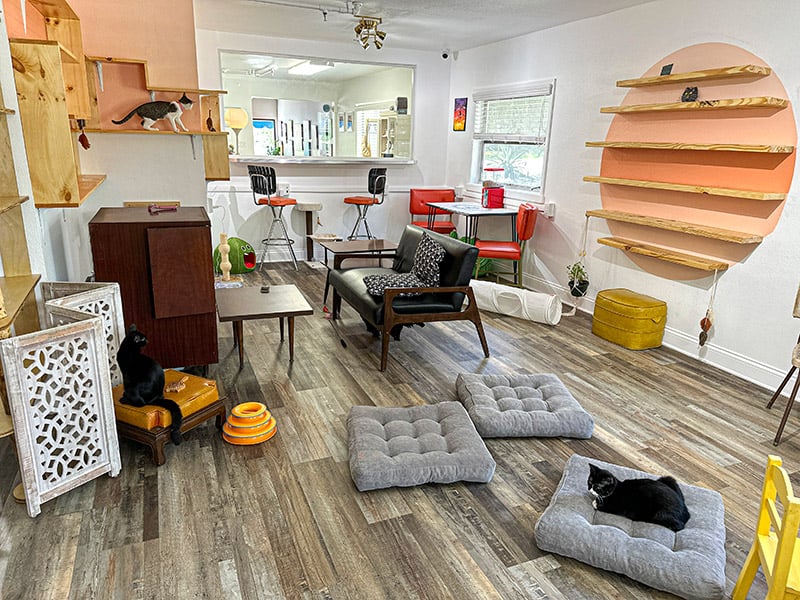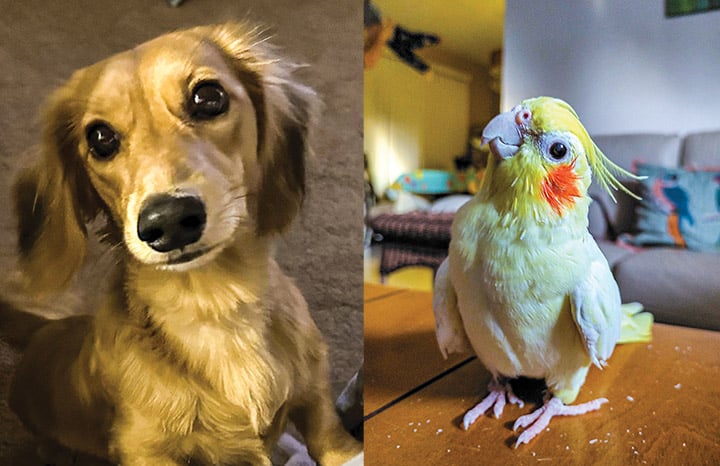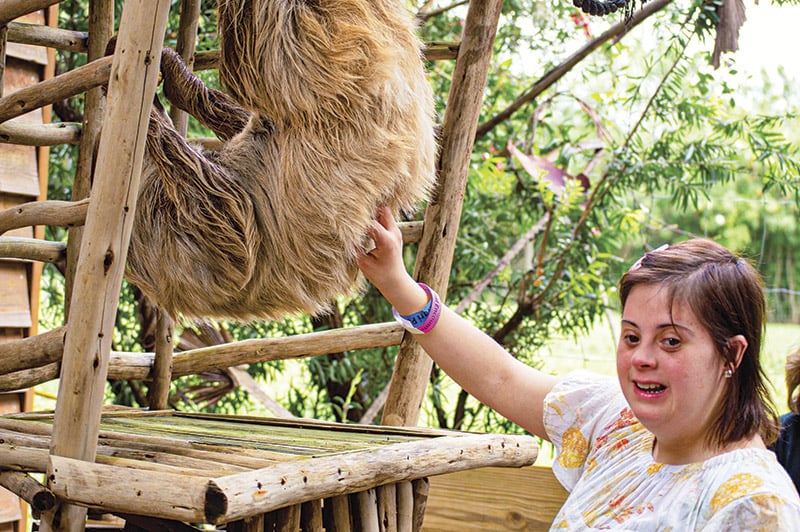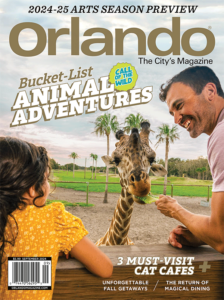Celebrating Pets: Happy Tales
In the midst of a pandemic, hearts melt, generous souls step up—and people find their forever friends.

Foster Parents Supreme: Lisa Krakosky And Jeff Higbee Give Animals Lots Of Love Until They Can Find Permanent Homes (JULIE FLETCHER)
When the coronavirus pandemic hit full force and Central Floridians were ordered to stay at home, one thing didn’t change: Thousands of dogs and cats cared for by animal shelters and rescue groups still needed forever homes.
Fortunately, many locals stepped up, through fostering and adoption, and happiness ensued— even in the time of coronavirus.
And it has continued, although adoption in many cases has gone virtual—with potential pet parents scrolling through an online lineup of animals, conducting meet-and-greets over Zoom, paying online, and arriving for curbside pickup.
Take Chloe Chase, a registered nurse at Orlando Health. She and boyfriend Travis Bradley had searched for a dog for a year. They started following the Instagram account of pet foster parents volunteering with Pet Alliance of Greater Orlando and discovered mom-to-be Dulce. The 5-year-old hound mix had given birth to eight pups after the pandemic took hold.
“We’d get notifications when they posted new pictures,” says Chase. She and Bradley had their eye on a pup named Fudge, but by the time they got on a Zoom call, Fudge had been adopted. “At that point, we knew we just wanted to rescue any dog from that litter.” So they moved quickly and chose an 8-week-old female name Stella, whom they picked up at Pet Alliance. “They brought her out to us in a little blanket. That’s the first time we got to meet her!” Chase says. “We took a leap of faith, but Pet Alliance was really supportive during the whole process.”
Although virtual adoptions make the best of an unfortunate situation, adoption numbers at Pet Alliance have dropped since the pandemic hit. Executive Director Steve Bardy attributes that to the closing of the shelter, which prevented people from dropping by for meet and greets. However, the Alliance has been allowing both virtual and by-appointment adoptions since May. So while you can’t come in to “just browse,” you can schedule to meet a specific dog or cat once you’ve checked out their online profile.
What has surged is the number of people stepping up to be pet foster parents, temporarily caring for animals in their homes and providing more attention and human interaction than typically found in shelters. Fostering can last a few days or stretch for months until the animal finds a permanent home.
“Fostering shot through the roof for most shelters,’’ Bardy says. “We had nearly 90 percent of animals in foster care because people wanted to help.” At Pet Rescue by Judy, animal advocate Kaley Anderson also noted a substantial increase in foster applications—50 to 100 per week when the pandemic started.
Lisa Krakosky and husband Jeff Higbee of Orlando are two of the many kind souls who have made a mission of fostering animals; they’ve been doing it since 2015. When the pandemic hit, they already had a house full of adopted fur babies—one dog and seven cats. The couple decided to add a group of fosters to that brood—18 of them to be exact, including the aforementioned Dulce and her puppies.
“Having foster animals during this time has provided a goal-oriented distraction to the chaos going on in the world around us,” says Krakosky. “They depend on us for survival from feeding and cleaning to socialization and snuggles. We help by caring for them until they’re able and ready to find their forever home.”
Adopting or fostering during a pandemic can have positive psychological effects. It’s almost as if animals and people—both in dire straits—are helping to save each other.
“With this pandemic and the stress of not having much to do or many places to go, adopting or fostering gives us purpose and responsibility,” says Caiti Bradbury, a licensed mental health counselor at the University of Central Florida. “It helps take away from our own problems and pain when we’re caring for animals.”
That’s exactly what drew UCF students Madison Kaminski and her boyfriend, Christian Yapp-Shing, to adopt two kittens. “I always had bad anxiety and depression, so having to stay home and not being able do anything was bad for my mental health,” Kaminski explains. A friend’s cat recently had a litter, so she and Yapp-Shing adopted two kittens. “One of the cats, Miyako, is officially my emotional support animal now,” says Kaminski. “The cats definitely made a big impact—I’ve been a lot more relaxed and less anxious.”
More Excellent Endings
Adopter: Jen Hancock, Orlando. A lifelong cat lover, Hancock usually adopts harder-to-place older felines. But after her beloved 15-year-old cat Panda passed last December, Hancock didn’t know if she was ready to open her heart again. Her two sons, Grayson and Weston, started begging for another cat—this time, a playful kitten. Fate stepped in when a friend posted a picture on Facebook of a kitten she had rescued. Hancock talked it over with her husband, Jon, and they decided to grant the boys their wish, bringing home little Leo. Both boys have taken responsibility for Leo, Hancock says. “It’s a labor of love for them.”
Adopters: Charlie and Megan Blunt, Deltona. Since his wife, Sandra, succumbed to cancer a few years ago, Charlie Blunt has been navigating life with his 15-year-old daughter, Megan. They had talked about getting a dog “someday,” but finally acted during the pandemic. They met Apollo, a three-legged pit bull, at Pet Rescue by Judy. “As soon as I saw Apollo, I knew immediately I wanted to adopt him,” recalls Megan. The shelter thought Apollo would never find a home because he didn’t really like people. Determined to win his heart, Megan volunteered at the rescue for three weeks before Apollo warmed up to her. Now, the two are inseparable. “Apollo doesn’t leave Megan’s side,” says Charlie. “He sleeps with her and follows her everywhere around the house.”
Fosters-Turned-Adopters: Josh and Lauren Powers, Winter Garden. The Powers family had previously adopted two dogs through Pet Alliance, where Josh serves on the board. With everyone home during the pandemic, they decided to foster 2-year-old Jolene, rescued from an animal hoarding case. Jolene has only one functioning eye, was severely underweight, and had little human interaction. “We made a crate available to her as a safe space, but we had to convince her it was safe to eat, drink, and move around the house,” says Josh. In the family’s care, Jolene (middle dog in photo) gained 12 pounds and got comfortable around people. “We simply couldn’t make her go through another transition,” says Josh. “We adopted Jolene about a month after we started fostering her. She’s now officially part of the Powers Pack!”
Pet Adoption and Fostering
Interested in giving an animal a forever or temporary home? Here are some tips to get you started. By Lisa A. Beach
While each animal shelter or rescue organization has its own criteria and procedure, the process typically starts with completing an application. Often, they’re available on the organization’s website. In the application, you provide details about your home environment (apartment, two-story house, big backyard), other people/pets in your home (live alone, young children, energetic dog), your work situation or availability (work-from-home, retired, 9-5 office hours), and lifestyle (sedentary senior, active millennial, frequent traveler). Once the organization understands who you are, it can better match the perfect animal to your lifestyle.
If you’re adopting, you’d normally go to the shelter, meet the animals in person, and choose the one that seems like a good fit, usually with the guidance of a trained staff member or volunteer. However, during the pandemic, much of this process has moved online, including virtual meet-and-greets. Typically, you pay a fee, which can range from $50 to $300+, depending on the age and type of animal. (Dogs usually cost more than cats, puppies and kittens usually cost more than adult animals.) The fee covers spay/neuter surgery, vaccines, health tests, and flea/heartworm prevention. You’ll need to stock up on basic supplies at home, such as cat/dog food, bowls, grooming supplies, collar/leash, litterbox and litter (for cats).
If you’re fostering, you’ll be providing a temporary home for animals while they await adoption. Both short-term and long-term foster opportunities are available, allowing for animals to heal, grow, and develop in a home environment rather than a shelter. There is no fee to foster and typically, the shelter provides food, supplies, and any needed medicine or veterinary care.
Shelters and Rescues: There are dozens of animal shelters and rescue organizations in Central Florida, along with county animal services departments. You’ll even find niche groups that specialize in only cats (Cats-Can), only dogs (Poodle and Pooch Rescue), special needs (Lovey Loaves Special Needs Rescue & Sanctuary), seniors (Senior Greyhound Adoption of Florida), certain sizes (Florida Little Dog Rescue), and certain breeds (Husky Haven of Florida). Here are a few additional resources to get you started:
- Candy’s Cats (Apopka)
- Central Florida Pug Rescue (Lake Mary)
- Helping Paws Humane Society (St. Cloud)
- Orange County Animal Services (Orlando)
- Orlando Cat Café (Clermont)
- Pet Alliance of Greater Orlando (Orlando and Sanford)
- Pet Rescue by Judy (Sanford)







